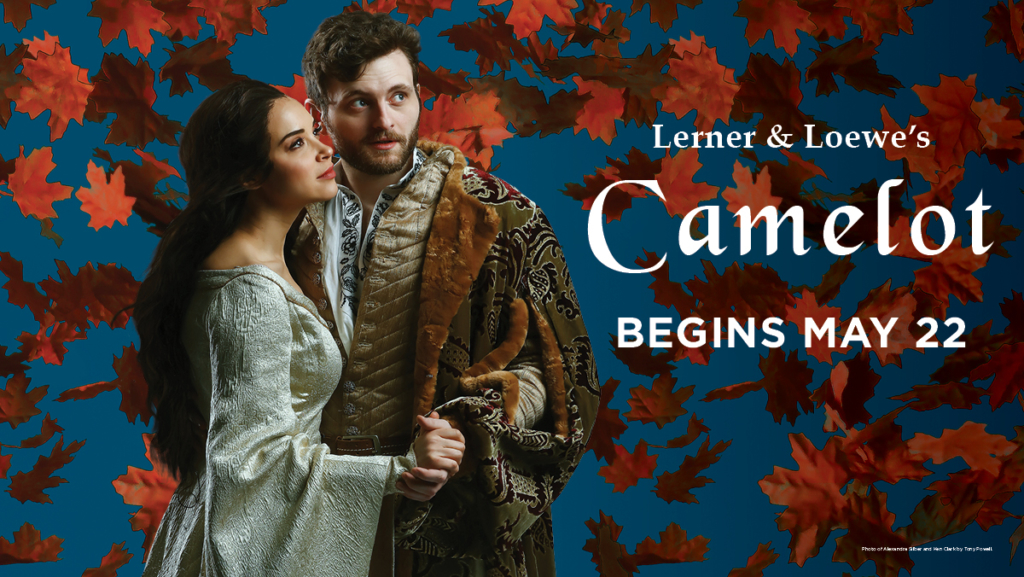Proposition: A show consisting of little more than pageantry and sentimental idealism can still find sturdy footing in the modern world with potent relevance to the happenings of today’s society in the hands of the right director.
Proposition: The right director, in this case Alan Paul, can take Lerner and Loewe’s Camelot, which is filled with pageantry and sentimental idealism, and transform it into something relevant and intriguing which reaches modern audiences on a relatable and interesting level.
Proposition: Camelot at Shakespeare Theatre Company is currently directed by Alan Paul and thus this production of Camelot is being presented with powerful footholds in modernity with relevancy to current affairs both domestic and international. With Musical Direction by James Cunningham and Choreography by Michele Lynch, this Camelot is one well worth seeing, experiencing, and learning anew, as if it were first being presented to audiences for its musical theatre debut. Paul and the production company has transformed a tired theatrical chestnut of history and placed it well within the entertaining and enjoyable grasp of the masses, and it’s all done subtly and with an exceptional handle on the pacing and cuts made along the way.
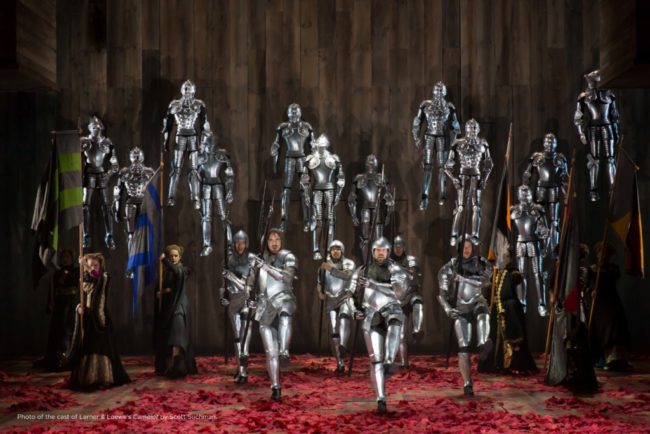
Deceptively minimalistic, Walt Spangler’s wooden set serves the show with great justice. The overlooking turrets that gently jut out from stage left and right— internally over the stage— are superb for staging the joust scene during “The Jousts”, particularly in combination with Robert Wierzel’s lighting. Much like the scenic approach, Wierzel’s lighting is minimalistic, used only to subtly enhance scenes and musical numbers, with the exception of the blazing embers that flare up in reds and oranges during “Fie on Goodness”, which is arguably the pivotal catalyst that launches the show into its conclusion, despite the intensity of the lights feeling a bit like overkill in this moment. Spangler’s crowning glory in the show— closely seconded by the ‘shining knights’ that descend from above— is the magnificent silver tree. A pure paragon of Arthur’s adolescence and strength all marvelously wrapped into one, the jungle-gym-esque set piece is more than just wondrous to gaze upon, but symbolic and delightfully functional as well.
The decadent pageantry that one expects to accompany any production of Camelot is not omitted from this production, but rather choses to showcase itself solely in the work of Costume Designer Ana Kuzmanic. The regal sweeps of navy and deep purple in fabrics of the most elegant velour adorn the knights and ladies in waiting when they first encounter the Queen-to-be. And the costumes which are featured on the aforementioned royalty are just as flashy, though not neglecting their regal sensibilities. Kuzmanic creates extravagant outfits for both King & Queen during the knighting ceremony of Lancelot but doesn’t scrimp on the details for these majesties in lesser scenes, like the glorious King and Queen bathrobes featured during the scene where Arthur’s mind is plagued with propositions over “might for right.”
Camelot, despite having little done by way of alteration, feels spry and sprightly, as “The Lusty Month of May” number implies. With new incidental music arranged and orchestrated by Michael Dansicker, there’s a giddy gallop that seems to flit rather freely throughout the progression of the piece, keeping it moving forward at quite the clip. Director Alan Paul has done very little to the script itself, but keeps the show blazing along, driving the actors with true motive rather than relying on the iconic musical numbers to carry the story. It is difficult to describe with any real justice what exactly it is he has done, short of calling it a transformation, as the show reads with modern relevancy yet is still clearly in period.
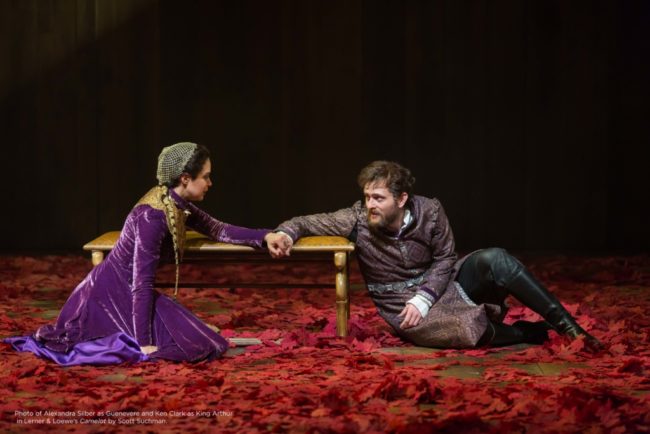
The actors tell the story; their anguishes and joys are celebrated fully, expressed readily, and made widely accessible to the audience. Paul creates moments within the musical numbers that better display the relationship dynamics, as well as the trials and tribulations, of these characters, making them more human, more real. The best example of this mastery at work is during “What Do the Simple Folk Do?” where the number is no longer focused on the silliness of which Arthur and Guenevere sing at one another, but rather about how their surface attempts to enjoy one another’s company cannot dispel the deeper tensions of their tortured angst and turmoil over the situation in which they find themselves regarding Lancelot.
Such moments populate the play constantly, making every instance of action— be it sung or spoke, danced or walked— engaging and gripping in a refreshing and invigorating manner. The trio of featured knights— Sir Dinadan (Mark Banik), Sir Sagramore (Brandon Bieber), Sir Lionel (Paul Victor) embrace such moments, like the innocent flirtations featured near the end of “The Lusty Month of May.” Banik, Bieber, and Victor are bold of voice, and strong of physical presence, giving themselves weight in that number as well as “The Jousts”, despite existing in appearance only in the latter of the two numbers.
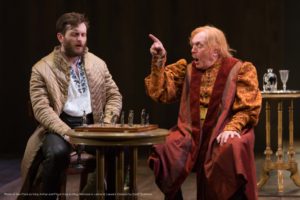
Alan Paul again approaches the show with the strong opinion that less is more, and fabricates Nimue (Melissa Wimbish) as little more than a shadowy figure projected high against the back wall of the set. With Wimbish’s mesmeric voice, “Follow Me” is as enchanting as it threatens to be, leading Merlyn (Ted van Griethuysen) away from his senses and his powers. Paul (and presumably Lighting Designer Robert Wierzel) uses the moving shadow effect for Merlin as well, throughout the production. Continuing on in the vein of simplicity, Paul choses to make King Pellinore (Floyd King) appear even more divorced from his senses by way of Horrid, the invisible dog. It’s quite charming the way King addresses the blank space, making him seem even more loosed from his wits than he might ordinarily. King’s performance is on par with the rest of the cast, his humors in touch and his gravitas well within reach of the constructed realms of existence of the performance.
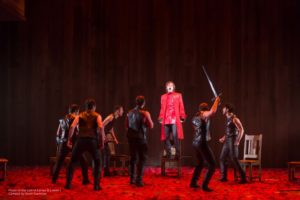
Though not arriving until the second act, Patrick Vaill’s Mordred is ripe and rotten; he is the perfectly pungent punk who arrives to spoil everyone’s fun, but deeply rooted in the evil that is at the base of man’s soul, far beyond that of what is expected of his perpetually petulant nature. Vaill explores a depth in Mordred that earns him a great chorus of booing during his curtain call— the mark of an exceptionally well-played antagonistic villain, as it were. There is more than just a juvenile mentality and pestilence fueling the Mordred character arc in Vaill’s performance. Putting an edgy grit into “The Seven Deadly Virtues” and a hint of snarky humor into some of the zestier one-liners he’s given, Vaill excels at being nefarious without having to try very hard to achieve such loathing from both on-stage characters and the audience. Using “Fie On Goodness” like a battle cry to revolting revolution, Vaill leads the knights into a rowdy romp of rage in this number.
Three powerhouse performers create the pristine points of the vexing triangular relationship that dominates Camelot. Ken Clark’s King Arthur, Alexandra Silber’s Guenevere, and Nick Fitzer’s Lancelot du Lac converge upon one another like the holy trinity of Lerner & Loewe’s religion; the weight of the show’s success, expedience, and sincerity is shared equally among them. The dynamic the craft with one another is stunning, particularly in those silent moments where the three exist together on stage. Even when it is only Arthur and Guenevere or only Guenevere and Lancelot or even still Lancelot and Arthur, there is always the sense that there are three. So extraordinary is their understanding of one another’s character portrayal and so intensely invested in these stories is this trio of performers that they are ever-present, even when physically absent from that scene.
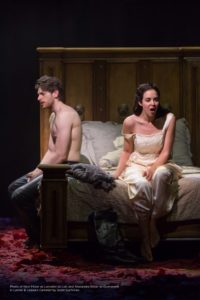
While “C’est Moi” is not without its braggart humors, bold hilarity, and utterly hilarious bravado, it is the first encounter of Fitzer’s astonishing voice, and one that sets the expectations high for his other numbers. Both “Madrigal” and “If Ever I Would Leave You” are carried smoothly, with deep emotional connections to the lyrics, in addition to being soothing and enchanting to the ear. Fitzer’s vocals are bold and buttery, daring and yet delicate when necessary, as is the versatility and depth that he brings to the overall portrayal of Lancelot. The forbidden glances at Guenevere, the stolid devotion to Arthur, the barely tempered fury directed at Mordred, all of these components are brought firmly together in a gripping performance given by Fitzer to craft an utterly perfect Lancelot.
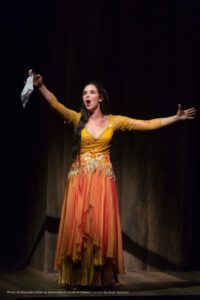
With a sassy and somewhat surprisingly saucy side, Alexandra Silber’s Guenevere is no flighty ingénue tiptoeing through the tulips and dancing delightfully around her dual romances. There is a bold and brazen energy that seizes Silber during “The Lusty Month of May”, creating a freeing frolic all throughout the number, which encourages an overall playfulness that spreads like wildfire through the ensemble in this scene. Vocally pristine with operatic pipes, both her tonal control, range, and emotional expression cause numbers like “I Love You Once in Silence” to be quite stunning. The ardent passion she expresses, in drastically different veins depending upon whether she’s with Arthur or Lancelot, is divine, giving Guenevere that dynamism that the character so desperately cries out for; this rewards the audience tremendously in a character that could readily be a simple ingénue.

Earnest, cheeky, dynamic, full of vibrancy and complexity, Ken Clark’s King Arthur is new and exciting. A true treat, Clark approaches Arthur as if he were the first to tackle the role, making it his own vivacious and unique creation with an eternal flame of spirit that informs his every move. In addition to his liveliness, Clark brings a hearty and perfectly-toned voice to the game, understanding the exact art of balance when it comes to patter verses ballad. His emotional connection to the music is as impressive as the depths to which he delves when Arthur is in conflict. Creating moving moments— like the one just before Lancelot is knighted and he addresses aloud his own consternations, desperately trying to weigh out his problems with his conscience and civility— Clark explores a fully fleshed-out vein of Arthur, the likes of which is seldom if ever at all seen when approaching productions of Camelot. His solo numbers are as compelling as numbers he shares with others and his command of stage presence is second to none, especially in the finale scene shared with Child (the precocious, tenacious, and spunky Trinity Sky Deabreu.)
Camelot. Camelot! The stuff of legends, the place of dreams, this is the production of both and you won’t want to miss this revitalizing effort being set down at Shakespeare Theatre Company this summer.
Running Time: 2 hours and 30 minutes with one intermission
Camelot plays through July 1, 2018 at Shakespeare Theatre Company in the Sidney Harman Hall— 610 F Street NW in the Judiciary Square—China Town neighborhood of Washington DC. For tickets call the box office at (20) 547-1122 or purchase them online.

